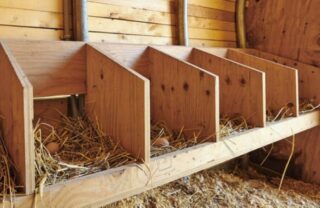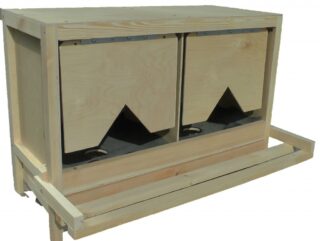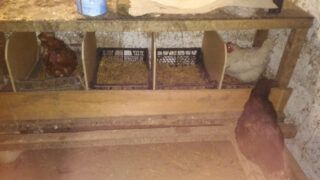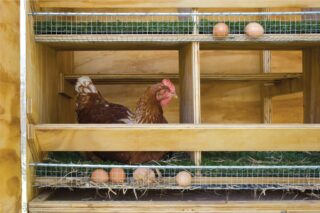Nests are arranged in the poultry house so that the chickens lay their eggs in a certain place. If there is no such device, laying hens find unexpected options on the floor, in a hole under a bush when free-range. Birds rush in shaded and hidden places, so making boxes is beneficial to the owner himself in order to limit the search for products. Nests in the hen house are placed for incubating offspring so that the chickens cannot peck and spoil the eggs.
The need for a nest and materials for construction

The nest contributes to the safety, cleanliness and integrity of poultry products. A well-defined corner reduces stress in chickens, increases egg production. In one nesting place 3 - 5 coughs are carried simultaneously. If the poultry house is small (5 - 10 heads), before the construction of capital structures, you can provide initial comfort with the use of available tools and materials.
Materials used:
- cardboard boxes, wooden containers of the correct size;
- wicker baskets, plastic containers are used;
- sometimes they use sections from old furniture with partitions, they even take old car tires and cut them out for convenience.
They are convinced of the integrity of the walls, the floor, the absence of sharp edges from cracks, chips, remove protruding nails and screws before making improvised nests.
They take into account the size of future nests in terms of area and height. In boxes that are too spacious or cramped, the bird will not want to rush. Over time, improvised installations are changed by capital nests. Without such adaptations, chickens are stressed, start looking for other places.
There are many different options for arranging nests. Insulated and simple boxes are used.
Requirements for the size and number of nests

Hay or straw is placed on the floor of the box, the second material is more preferable, because the dry grass of the nest is thrown outside the perimeter. The flooring should be placed 1.5 - 2.0 cm below the side to prevent the egg from rolling out.
Construction requirements:
- provide ventilation so that the flooring is ventilated, and the nest is dry, in this case the mesh bottom helps;
- it is better not to fasten the nest to the wall - this option is short-lived, the chickens are uncomfortable in it;
- the inner surfaces must be smooth and free from damage.
Perch bars are placed at a distance of 25 cm from each other for broilers, 30 - 40 cm - for meat breeds. The poles should not be short, since the chickens do not get enough sleep, and egg production decreases. You can check the correctness of the chicken roost by observing the behavior of the pets. If they do not adapt in any way, they move to other places, then mistakes and mistakes were made in the manufacture.
Dimensional standards depending on the breed:
- length, width and height of the nest for laying hens - 35 x 25 x 35 m;
- for meat-bearing species - 40 x 30 x 45 cm.
If there is a large livestock in the hen house, nests are placed in 2 - 3 tiers. The first floor is located at a height of 30 cm from the floor. The nest lane is made at least 5 cm. A take-off shelf is mounted in front of the entrance, it is placed with an interval of 10 cm from the entrance to the nesting site. The lid of the egg box is tilted at an angle of 45 ° to make it uncomfortable for the chickens to sit on top.
Varieties of nests

There are solid structures or structures that are temporarily used.The second type is not convenient, but this is a way out, if in the future there is a possibility of capital development.
For the manufacture of any type, wooden lumber is used, plastic containers are considered as a temporary place. Prepare plywood, chipboard plates, you can take slats, bars.
Common patterns:
- Fast socket. They use improvised materials, more often they take cardboard boxes. The nest soon deteriorates, it is problematic to clean it. For all chickens, it is difficult to constantly select boxes of the required dimensions. Plastic containers can be harmful to pets and often give off a specific odor.
- Nest booth. They are made from plastic containers, for example, a vegetable box, which is equipped with walls and a roof made of plywood. The bulky structure is not always convenient for layers, and in winter it cools quickly. The booth can be built without the skills of working with lumber. Minus in the absence of a collection for eggs.
- Nest box. A simple design, for which they take wooden boxes, then finish the walls with chipboard, hardboard, plywood. The laying hen is locked for a while in such a corner so that she gets used to using the nest. There is a kind of spacious drawer with several compartments separated by partitions.
- With egg collector. The design and dimensions of such a socket may be different, but the principle of operation is always the same. After incubation by the chicken, the egg is immediately transferred to a special tray, while the hen does not touch it. The topical solution for a large number of poultry houses.
- Double bottom. The design is intended to prevent the clucks from pecking eggs. A second bottom is made under the floor, into which a hole in the center of the floor leads into a nest with a diameter of about 10 cm. The product falls through, falls into the pallet, the plane of which is inclined by 40 °.
- Nest with container for eggs. The bottom of the nest itself is made with a slope of 5 ° so that the egg rolls into the back. There is a slot 8-10 cm wide, through which it falls into the pallet with the front bar. From the tray, the eggs are transferred to the container through an opening or slot.
- Family nest. Designed for several individuals (2 - 5). The area is made so that for one hen it is from 100 cm². In this design, there is a shelf for droppings, an egg collector, a feeder, and a water tank. The partitions are made of mesh.
- Frame type. Contains a skeleton of bars or thick slats at the base. The walls of the nest are sheathed with plywood, thin boards, and a cover is made of the same materials. The egg collector may or may not be included in the design. Insulation is done in the walls between the frame elements.
The metal nest is a box made of sheets of steel, sometimes a lattice structure is made, it is sheathed with wood, and curtains are made. A metal product lasts a long time, but requires more manufacturing costs.
Accommodation rules

Place nests in areas of the coop where there is little darkening compared to the rest of the area. This should be a windproof place away from the entrance, since it is the coldest and most vulnerable area. In summer, the temperature inside the nest is maintained at + 25 ° C, in winter at least + 15 ° C.
Location requirements:
- Dryness of the site. Damp bedding at the bottom causes colds and other illnesses.
- Lack of drafts. The boxes are placed in the back, where there are no windows.
- Above the floor. You cannot make a nest in the house directly on the floor.
Nests are placed next to each other if there is not enough space in the chicken coop. In multi-tiered structures, companions are provided for pets, along which they go down to the floor. The material is boards or bars.
A container with ash and sand is placed nearby. Bathing prevents the appearance and development of skin parasites, and layers will not bring them into the nest.
Instructions for making nests

The work will require tools for cutting and processing wood. The assembly is carried out using a screwdriver.To clean the boards and joints, sandpaper No. 60 - 200 is used. Initially, a frame is made of bars, the elements are connected using self-tapping screws or screws 60 - 80 mm long. It is allowed to knock down with nails.
Further steps for arrangement:
- The frame is fixed on pavement pads in order to maintain the distance from the floor, fixed to the wall with dowels or self-tapping screws, depending on the material of the chicken coop fences.
- A skeleton is made for the second bottom under the nest of rails, a protective bar is attached.
- Measure the dimensions of the sheathing sheets on all planes, cut them out of plywood.
- They cover the frame, put insulation in the form of foam plastic, mineral wool, sew up with plywood.
- The egg receptacle is sheathed with soft materials, for example, felt, felt.
- The structure is divided into sections by partitions made of steel mesh, which is fixed to the side, bottom and top bars so that the edge is closed.
After that, a staircase is built from the floor to the entrance to each section. They take a board, transverse bars are attached to it for the convenience of climbing. The compartments are filled with sawdust. A stationary cover is rarely performed, more often it is made removable for cleaning and processing of internal surfaces. The front entrance is closed with fabric curtains.
Useful Tips

The pallet in front should protrude 10 cm from the bottom of the nest so that it is convenient to take out the eggs. In multi-storey structures, containers for assembly are performed at each level. It is troublesome, but it will save the production and it will remain clean.
Hanging nests are designed to collect eggs from the outside without going into the house. The constructions are convenient, but they need to be insulated with all composite fences, including the floor and roof.
When arranging nests, it is taken into account that the owner must go to them to change the litter, collect products. The dimensions inside the container, the egg receptacle, must be such that the eggs do not get stuck in the gap. Avoid using thick padding to reduce space.








